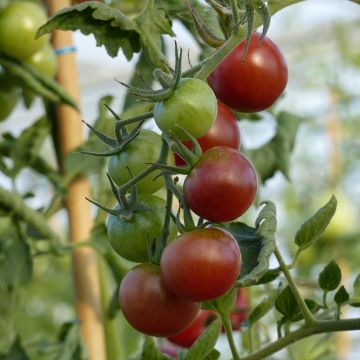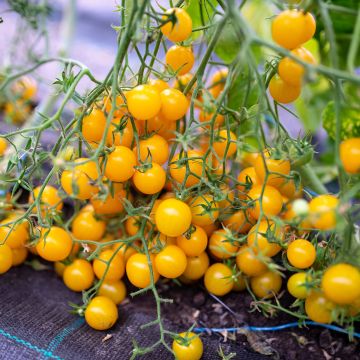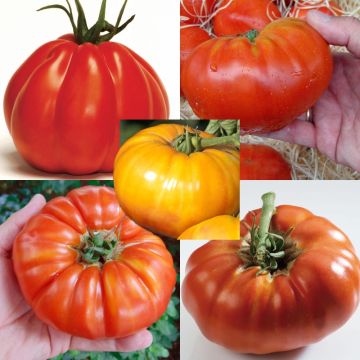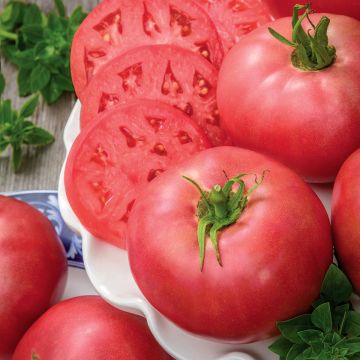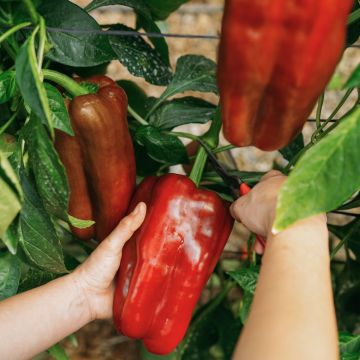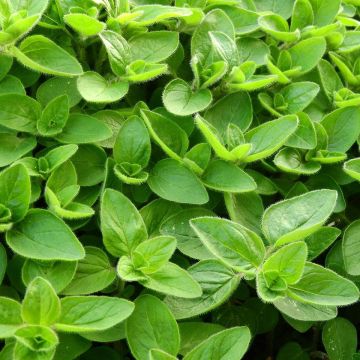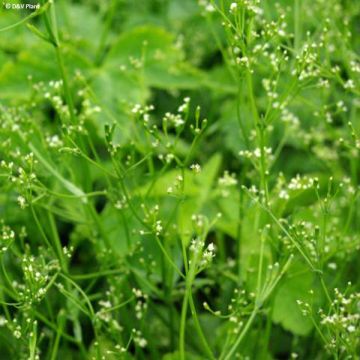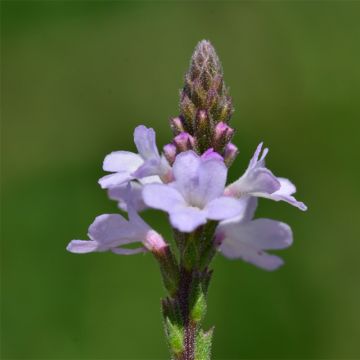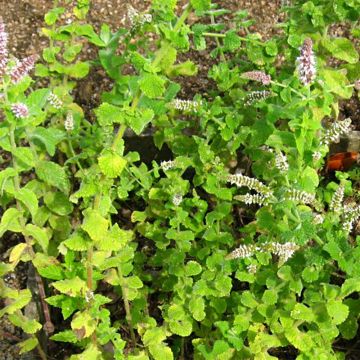

Cucumber Vert Petit de Paris plants - Cucumis sativus
Cucumber Vert Petit de Paris plants - Cucumis sativus
Cucumis sativus Vert Petit de Paris
Cucumber
Unfortunately, one has only the stem left and the other only a leaf.
Frédérique B., 06/05/2019
Why not try an alternative variety in stock?
View all →This plant carries a 6 months recovery warranty
More information
We guarantee the quality of our plants for a full growing cycle, and will replace at our expense any plant that fails to recover under normal climatic and planting conditions.
From €5.90 for pickup delivery and €6.90 for home delivery
Express home delivery from €8.90.
From €5.90 for pickup delivery and €6.90 for home delivery
Express home delivery from €8.90.
Description
The Parisian Small Green Gherkin is a hardy and productive variety that produces short cylindrical fruits. It is a vigorous gherkin with a good yield and a very delicate flavour that does not require pruning.
Gherkins and cucumbers belong to the same species, but gherkins are picked prematurely to be pickled in vinegar, accompanied by small onions, peppercorns, and tarragon.
This is a vegetable that can be stored for a long time and is traditionally enjoyed as a condiment in salads or to accompany charcuterie dishes.
Gherkins prefer light, loose, moist, and humus-rich soils. They thrive in sunny locations and temperatures between 18 and 22°C (64.4 and 71.6°F). They are quite water-demanding vegetables that need regular irrigation.
Harvest: Gherkins are harvested 3 to 4 months after sowing and before the fruits reach their final size. Harvesting should be done very regularly, ideally every two days during peak production, as they grow rapidly and won't wait to turn into cucumbers! Furthermore, regular harvesting encourages the formation of new fruits.
Storage: Freshly harvested gherkins can be stored in the refrigerator for a few days before being pickled in vinegar.
Gardener's tip: Like all cucurbits, gherkins can be susceptible to powdery mildew: a white fuzz appears on the leaves. It is advisable to remove heavily affected leaves and spray with wettable sulfur every 2 weeks. In case of a minor attack, you can also treat the plants with skimmed milk diluted at 10 to 20% in rainwater. As a preventive measure, avoid watering the foliage and ensure good ventilation in your greenhouse if the cultivation takes place under cover. A decoction of horsetail can also be applied to strengthen the foliage's resistance.
Report an error about the product description
Harvest
Plant habit
Foliage
Other Vegetable plants A to Z
Planting and care
Planting:
Planting in open ground is done from mid-May to June, when the soil is sufficiently warmed up and the risk of frost has passed. Space the plants 1m (3ft) apart in all directions if growing flat or 1m (3ft) between rows and 50 cm (20in) within the row if training. Dig a hole, place your plant with the collar level with the ground and cover with fine soil. Firm and water generously.
Cucumber cultivation:
Cucumber is a fairly demanding vegetable, which requires well-fertilised soil. It is advisable to apply mature compost (about 3 kg per m2) preferably in autumn, by scratching to a depth of 5 cm (2in), after having, as for any vegetable crop, thoroughly loosened the soil. It thrives in neutral soils (PH 7) but will also do well in slightly acidic or alkaline soil (PH between 5.5 and 7.5).
Cucumbers can be grown flat, but to save space, don't hesitate to exploit their climbing nature by training them: on a frame covered with wire mesh, inclined at 45 degrees, they will provide beneficial shade for lettuces or even in a tipi to add a touch of whimsy to the vegetable garden.
When the plants are trained vertically, the cultivation is done with a single stem, which is pinched at a height of 2.5 metres (8 feet). When grown flat, pinch above the second leaf to obtain two stems, which will then be pinched above the 4th leaf. The final pruning involves cutting to a leaf above each formed fruit.
Cucumbers go well with corn, but avoid planting them near tomatoes and potatoes.
Cultivation
Care
Intended location
-
, onOrder confirmed
Reply from on Promesse de fleurs
Vegetable plants
Haven't found what you were looking for?
Hardiness is the lowest winter temperature a plant can endure without suffering serious damage or even dying. However, hardiness is affected by location (a sheltered area, such as a patio), protection (winter cover) and soil type (hardiness is improved by well-drained soil).

Photo Sharing Terms & Conditions
In order to encourage gardeners to interact and share their experiences, Promesse de fleurs offers various media enabling content to be uploaded onto its Site - in particular via the ‘Photo sharing’ module.
The User agrees to refrain from:
- Posting any content that is illegal, prejudicial, insulting, racist, inciteful to hatred, revisionist, contrary to public decency, that infringes on privacy or on the privacy rights of third parties, in particular the publicity rights of persons and goods, intellectual property rights, or the right to privacy.
- Submitting content on behalf of a third party;
- Impersonate the identity of a third party and/or publish any personal information about a third party;
In general, the User undertakes to refrain from any unethical behaviour.
All Content (in particular text, comments, files, images, photos, videos, creative works, etc.), which may be subject to property or intellectual property rights, image or other private rights, shall remain the property of the User, subject to the limited rights granted by the terms of the licence granted by Promesse de fleurs as stated below. Users are at liberty to publish or not to publish such Content on the Site, notably via the ‘Photo Sharing’ facility, and accept that this Content shall be made public and freely accessible, notably on the Internet.
Users further acknowledge, undertake to have ,and guarantee that they hold all necessary rights and permissions to publish such material on the Site, in particular with regard to the legislation in force pertaining to any privacy, property, intellectual property, image, or contractual rights, or rights of any other nature. By publishing such Content on the Site, Users acknowledge accepting full liability as publishers of the Content within the meaning of the law, and grant Promesse de fleurs, free of charge, an inclusive, worldwide licence for the said Content for the entire duration of its publication, including all reproduction, representation, up/downloading, displaying, performing, transmission, and storage rights.
Users also grant permission for their name to be linked to the Content and accept that this link may not always be made available.
By engaging in posting material, Users consent to their Content becoming automatically accessible on the Internet, in particular on other sites and/or blogs and/or web pages of the Promesse de fleurs site, including in particular social pages and the Promesse de fleurs catalogue.
Users may secure the removal of entrusted content free of charge by issuing a simple request via our contact form.
The flowering period indicated on our website applies to countries and regions located in USDA zone 8 (France, the United Kingdom, Ireland, the Netherlands, etc.)
It will vary according to where you live:
- In zones 9 to 10 (Italy, Spain, Greece, etc.), flowering will occur about 2 to 4 weeks earlier.
- In zones 6 to 7 (Germany, Poland, Slovenia, and lower mountainous regions), flowering will be delayed by 2 to 3 weeks.
- In zone 5 (Central Europe, Scandinavia), blooming will be delayed by 3 to 5 weeks.
In temperate climates, pruning of spring-flowering shrubs (forsythia, spireas, etc.) should be done just after flowering.
Pruning of summer-flowering shrubs (Indian Lilac, Perovskia, etc.) can be done in winter or spring.
In cold regions as well as with frost-sensitive plants, avoid pruning too early when severe frosts may still occur.
The planting period indicated on our website applies to countries and regions located in USDA zone 8 (France, United Kingdom, Ireland, Netherlands).
It will vary according to where you live:
- In Mediterranean zones (Marseille, Madrid, Milan, etc.), autumn and winter are the best planting periods.
- In continental zones (Strasbourg, Munich, Vienna, etc.), delay planting by 2 to 3 weeks in spring and bring it forward by 2 to 4 weeks in autumn.
- In mountainous regions (the Alps, Pyrenees, Carpathians, etc.), it is best to plant in late spring (May-June) or late summer (August-September).
The harvesting period indicated on our website applies to countries and regions in USDA zone 8 (France, England, Ireland, the Netherlands).
In colder areas (Scandinavia, Poland, Austria...) fruit and vegetable harvests are likely to be delayed by 3-4 weeks.
In warmer areas (Italy, Spain, Greece, etc.), harvesting will probably take place earlier, depending on weather conditions.
The sowing periods indicated on our website apply to countries and regions within USDA Zone 8 (France, UK, Ireland, Netherlands).
In colder areas (Scandinavia, Poland, Austria...), delay any outdoor sowing by 3-4 weeks, or sow under glass.
In warmer climes (Italy, Spain, Greece, etc.), bring outdoor sowing forward by a few weeks.







































